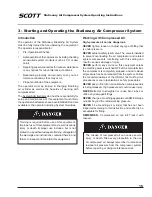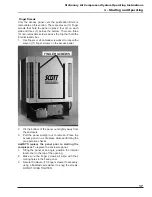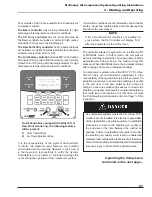
Stationary Air Compressor System Operating Instructions
3 - Starting and Operating
26
Use of the Purge
When the CO or dew point readings approach or reach
a shutdown the Purge function can be used to expel
suspect air after the air purifiers before it goes into the
storage cylinders.
To activate the Purge cycle, press the PURGE button on
the X4 Controller keypad and follow the instructions on
the display. The Purge light on the panel will go on and
the air in the purifiers will be vented to the atmosphere.
The display will continue to show CO and dew point levels
and will let you know when they are back in an accept
-
able range. The Purge cycle will NOT end automatically
unless the CO AND the dew point levels are below the
alarm levels. You must press the STOP button and follow
the instructions on the display to end the Purge cycle and
return to normal operation.
The operator must continue to watch the CO, dew point,
and temperature readings for indications that conditions
may again approach or reach out-of-tolerance levels.
System Tolerances and Overrides
The X4 Controller monitors certain system conditions
during compressor operation including the following:
• Compressor oil level or pressure is measured within
the compressor,
• Compressor discharge air temperature (°F)
is measure at the final stage outlet of the
compressor,
• Carbon Monoxide (CO) is measured after the final
air purifier,
• Dew Point level (DP) is measured after the final air
purifier.
The system will alarm
if conditions approach out-of-
tolerance limits, and will subsequently shutdown
the
compressor when the limits are exceeded.
Compressor Operating Parameters
Air temperature (°F)
470°
495°
550°
Dew Point–DP (°F)
-64°
-55°
-10°
Carbon Monoxide (CO)
4 ppm
6 ppm
30 ppm
Alarm
Parameter
Override
Maximum
Shut-
down
These are the factory pre-set alarm and shutdown set
points. Other set points may be programmed by the
System Administrator.
Operating the Compressor Continued...
Press the Purge
Button to begin
the Purifier Purge
Cycle
When the readings reach ALARM levels, the operator
has the option to Purge the suspect air which may cor-
rect the problem, or to keep operating the compressor.
When the readings reach the SHUTDOWN levels, the
operator must select OVERRIDE to continue producing
air for a limited time. Again, use of the PURGE may cor
-
rect some temporary out-of-tolerance conditions and
prevent another Shutdown warning.
The
Overrides
should only be used in emergency situ
-
ations where there is a compelling reason to continue
producing breathing air, such as to save a life. The
Override capability must be ENABLED by the
System
Administrator
who has the responsibility for maintenance
of this equipment.
An out-of-tolerance condition indicates a problem or
potential problem with the compressor system that must
be checked and corrected as soon as possible.
• Low compressor oil level or pressure indicates
insufficient oil to operate the compressor.
• High compressor discharge air temperature may
indicate a high ambient air temperature condition
OR a problem in the compressor. Determine the
cause of the problem as soon as possible.
• High CO may indicate the presence of a source of
vehicle exhaust in proximity to the compressor air
intake.
• High dew point may indicate moisture accumulation
in the air intake, residual moisture in the system
from non-use of the compressor, a problem with the
condensation drain system, or a need to replace the
purification filters.
The X4 Controller displays readings for the discharge
outlet temperature, the CO level, and the dew point while
the compressor is running. The operator must watch
these readings for indications that conditions may ap
-
proach out-of-tolerance levels. The system PURGE can
be used at any time and may correct some temporary
out-of-tolerance conditions.
NOTE
DO NOT use the Purge Cycle to attempt to “dry out”
the air when the dew point readings are already out
of tolerance.
Summary of Contents for HUSH
Page 2: ......
Page 21: ...3 Starting and Operating Stationary Air Compressor System Operating Instructions 19 NOTES ...
Page 34: ...Stationary Air Compressor System Operating Instructions 4 Operator Maintenance 32 NOTES ...
Page 38: ...Stationary Air Compressor System Operating Instructions 5 Additional Features 36 NOTES ...
Page 45: ...43 Maintenance Record ...
Page 46: ...44 NOTES ...
Page 47: ......
















































